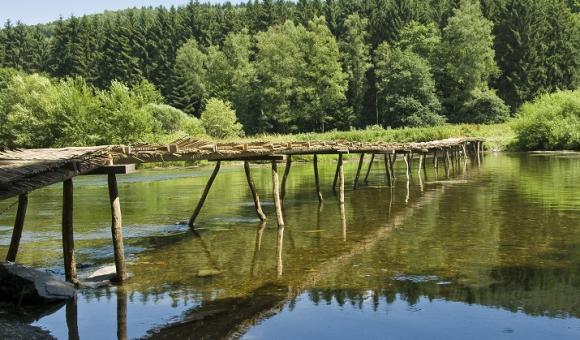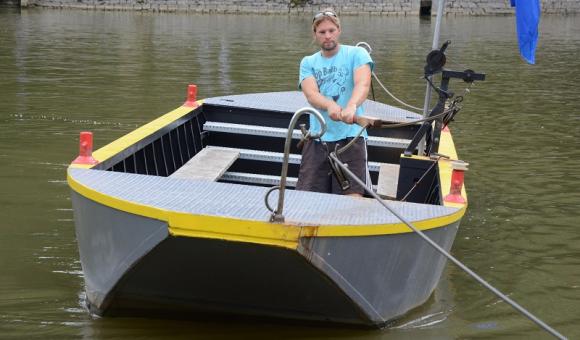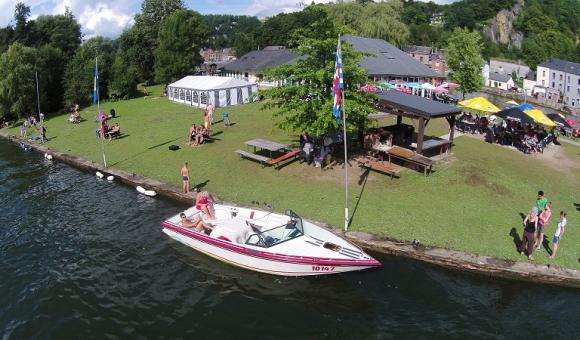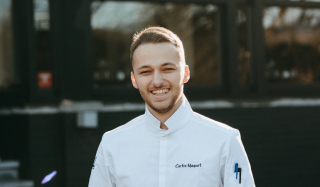
2019’s special theme for tourism in Wallonia is water. Now is the time to (re)discover all of the natural wonders of our rivers, streams and watercourses, as well as the holiday and leisure activities which they offer. Either on the water or its banks, or enjoying its benefits from the point of view of welfare or local produce.
Small selection, necessarily subjective, it is all about putting… water to our mouths.
Waulsort: where ferries cross constantly
Michel is the last remaining ferryman on the water of the Meuse. He provides the link between the banks of the river at Waulsort and perpetuates a nearly 150-year-old tradition.
“It is a great job, in the open air, under no pressure. In the early days, it was just a bit of fun, but then I decided I liked it”. Aboard his boat without a care in the world, Michel Remy, aged 32, feels like… a fish in water. He has been doing his much-loved job, that of a manual ferryman, for nearly four years now. He is also the very last to operate a ferry across the Meuse and is perpetuating a tradition which dates back to 1871. At the time, it was above all about enabling people living in Falmignoul, a village nestling on the right bank, to access the Dinant-Givet rail line, opened seven years earlier, on the left bank.
The ferry is a boat with two benches running its full length, operated by a cable and a system of pulleys. The cable links the two banks and lies on the river bed. The ferryman pulls on the cable using a piece of machinery known as a “rabot” or “sabot”, made out of the wood of an old dam needle. The crossing takes five to ten minutes, depending on the weather conditions at the time. “When there is a north wind, it pushes the boat against the cable and life gets quite difficult”, explains Michel. And the speed of the current? “It is especially a problem in winter, though hardly ever in summer, so no trouble at that time of year”.
You guessed it: the ferryman’s “clients” are now essentially tourists, hikers and even sailors who have launched their boat at the marina on the right bank, and who are crossing the river to go into the village of Waulsort. The marina side offers a panoramic view of the opposite bank, with period houses and hotels which are also testament to the pace of tourism in the first half of the twentieth century, when Waulsort was a kind of Haute-Meuse Riviera.
No matter who the client is, the price is the same for everyone: it is… free. Because the activity has become a real tourist attraction managed by the local tourist office. So the ferryman is a seasonal worker paid by the town of Hastière. In high season, there is no time for him to get bored, especially when the sun is out. He may do several crossings a day, purely with the strength of his arms.
There are crossings daily from 1 April to the end of September, from 10 a.m. to 6 p.m. Monday to Thursday, and from 10 a.m. to 7:30 p.m. Friday to Sunday. Out of hours, you can cross on foot or by bike using the Waulsort bridge, 500 metres upstream.
Rafting on the Semois
A peaceful trip down the Semois, in magnificent leafy surroundings, right in the heart of the Ardennes. An activity reserved only for groups of at least 16 people. First and foremost, on site, you need to make your raft using logs, air pockets and lashing. Launch takes place at Poupehan for a 6 km trip and at Frahan for a 4 km one. From the Easter holiday to the All Saints holiday: booking is compulsory.
Hotton: Riveo - CoSMos
Flora and fauna intertwine, making for an aquatic spectacle in its natural state: at Hotton, the Riveo interpretation centre, located at the foot of the Ourthe, especially focusses on a reconstituted 12-metre-long arm of the river and 16 aquaria, inviting you to learn about the fish in our rivers. Themed gardens also cover 1,500 m². In the neighbouring village of Erezée, State-owned fish farms include CoSMos- L’Odyssée du saumon, which tells the story of this unusual fish and efforts made to reintroduce the fish to Walloon watercourses.
Escabeche
Escabeche is a fish dish preserved in vinegar, typical of Sud-Hainaut and Namur, especially the regions of Chimay, Virelles and Olloy-sur-Viroin. The original recipe is eel-based, but may also be made using other fish such as trout and pike. The origin of the dish dates back to the Spanish occupation of the region of Chimay. Now, most of the region’s restaurants offer it hot or cold, as an aperitif, starter or main course, the latter accompanied by a salad, bread or even chips.
The Île d’Yvoir
On the Meuse between Namur and Dinant. It is Belgium’s only island to be used for tourism. In two minutes, an automated ferryman will take you to this piece of land surrounded by water. There is a wild part ideal for taking a walk with the birds and the trees. The island’s relaxation area and terrace offer a variety of leisure activities, a paddling pool, games area, and kayaks and pedalos for hire.
Remouchamps caves
The site has been visited by tourists since 1828. Going there, it is on foot that you pass through galleries and spectacle rooms including the famous “Cathédrale”, which rises to a height of 40 metres, and which could therefore easily contain a 12-storey block. You come back in a boat, along the river which meanders on the lower floor of the caves. Covering about 70 metres, it is Belgium’s longest underground navigation.
Aquascope de Virelles
A nature centre, made of glass and wood, built on the banks of the Virelles lake. Everything has been done there for you to explore rich, preserved nature. With its reed bed and approximately 80-hectare lake, Aquascope offers a combination of tourism, education and environmental protection. With winding footpaths and observation posts, you can enjoy a day “surrounded by nature”.
L’Aquacentre de l’Eau d’Heure
Two attractions which complement each other. Firstly, the waterpark, combining sports and leisure with an indoor and an outdoor swimming pool, a spray park for when the weather is good, with fun jets and water-based games, and also, of course, sporting activities: aquabiking, aquadancing, aquagym. Secondly, a Welfare Centre which lends itself to relaxation, with jacuzzi, sauna, hammam, luminotherapy and à la carte care. Note that the Eau d’Heure site is especially known for this vast leisure centre, built around five lakes and covering a total surface area of 6.17 km². The banks are a total of 67 km in length. The ideal place for some fun.
Renipont Plage
In the Walloon Brabant, between Lasne and Rixensart, Renipont Plage is a wonderful, natural, outdoor swimming pool which stands in 9 hectares of leafy surroundings, one part classified as “Natura 2000”. A small lake, fed by a source which renews the water constantly, is laid out like a beach for leisure activities on the water. Take a walk and discover the large neighbouring lake, then continue into the forest nearby. And alongside, the River Lasne constantly flows.
The village of Laforêt
Located alongside the Semois, this absolutely beautiful village retains features from a bygone age: watering holes and tobacco washing and drying facilities. In its heyday, anyone courageous would cross the unexpected “Pont de Claies”, rebuilt every year in season for crossing from one bank to the other. At one end of the village, you can admire a small collection of items related to water, including a facility with a covered wash house from the early twentieth century, a blue stone watering hole and a fountain.
Thuin: the world of canal transport
An old merchant barge moored at Sambre quay has been converted to a museum. It is the place to learn about the world of canal transport, the stages of boat construction, communication systems, wartime events, life on board... Different themes are covered through documents and witness statements from the era, including postcards, construction plans, prototypes and other items.
Annevoie Gardens
These are Wallonia’s only water gardens. Laid out 250 years ago, they are home to fountains, waterfalls, lakes and water jets, through orderly French-style gardens, intimate Italian-style gardens and even more wild English-style gardens. The gardens use no machinery. The water flows naturally, with only natural gradients. Open from 30th March to 30th November.
Genval lake
This is located about twenty kilometres south of Brussels, in superb leafy surroundings, on the edge of Soignes forest. As well as walks through fields, the lake offers activities of choice such as fishing, sailing and rowing. Several restaurants on the water’s edge provide the opportunity to combine the delights of dining with the soothing tranquillity of a delightful place.
Article written by Jean-Marie Antoine, taken from Revue W+B n°143
For all information on the themed year “Wallonia, the land of water”, visit the Wallonie Belgique Tourisme website









